Assessing Vulnerability to Heat: A Geospatial Analysis for the City of Philadelphia
Abstract
:1. Introduction
2. Methods
3. Results
4. Discussion
5. Conclusions
Acknowledgments
Author Contributions
Conflicts of Interest
References
- Arnfield, A.J. Two decades of urban climate research: A review of turbulence, exchanges of energy and water, and the urban heat island. Int. J. Climatol. 2003, 23, 1–26. [Google Scholar] [CrossRef]
- Clarke, J.F. Some effects of the urban structure on heat mortality. Environ. Res. 1972, 5, 93–104. Available online: https://www.sciencedirect.com/science/article/pii/0013935172900230 (accessed on 4 February 2017). [CrossRef]
- Karl, T.R.; Jones, P.D. Urban bias in area-averaged surface air temperature trends. Bull. Am. Meteorol. Soc. 1989, 70, 265–270. Available online: https://journals.ametsoc.org/doi/abs/10.1175/1520-0477%281989%29070%3C0265%3AUBIAAS%3E2.0.CO%3B2 (accessed on 1 February 2017). [CrossRef]
- Oke, T.R. The energetic basis of the urban heat island. Q. J. R. Meteorol. Soc. 1982, 108, 1–24. Available online: http://onlinelibrary.wiley.com/doi/10.1002/qj.49710845502/full (accessed on 4 February 2017). [CrossRef]
- Reid, C.E.; Mann, J.K.; Alfasso, R.; English, P.B.; King, G.C.; Lincoln, R.A.; Margolis, H.G.; Rubado, D.J.; Sabato, J.E.; West, N.L.; et al. Evaluation of a heat vulnerability index on abnormally hot days: An environmental public health tracking study. Environ. Health Perspect. 2012, 120, 715. Available online: https://www.ncbi.nlm.nih.gov/pmc/articles/PMC3346770/ (accessed on 30 January 2017). [CrossRef] [PubMed]
- Weber, S.; Sadoff, N.; Zell, E.; de Sherbinin, A. Policy-relevant indicators for mapping the vulnerability of urban populations to extreme heat events: A case study of Philadelphia. Appl. Geogr. 2015, 63, 231–243. Available online: https://www.sciencedirect.com/science/article/pii/S014362281500171X (accessed on 16 March 2018). [CrossRef]
- Cartalis, C.; Synodinou, A.; Proedrou, M.; Tsangrassoulis, A.; Santamouris, M. Modifications in energy demand in urban areas as a result of climate changes: An assessment for the southeast Mediterranean region. Energy Convers. Manag. 2001, 42, 1647–1656. Available online: https://www.sciencedirect.com/science/article/pii/S0196890400001564 (accessed on 30 January 2017). [CrossRef]
- Luber, G.; McGeehin, M. Climate change and extreme heat events. Am. J. Prev. Med. 2008, 35, 429–435. Available online: http://www.ajpmonline.org/article/S0749-3797(08)00686-7/abstract (accessed on 4 February 2017). [CrossRef] [PubMed]
- Bradford, K.; Abrahams, L.; Hegglin, M.; Klima, K. A heat vulnerability index and adaptation solutions for Pittsburgh, Pennsylvania. Environ. Sci. Technol. 2015, 49, 11303–11311. Available online: https://pubs.acs.org/doi/abs/10.1021/acs.est.5b03127 (accessed on 30 January 2017). [CrossRef] [PubMed]
- Goward, S.N. Thermal behavior of urban landscapes and the urban heat island. Phys. Geogr. 1981, 2, 19–33. Available online: http://www.tandfonline.com/doi/abs/10.1080/02723646.1981.10642202 (accessed on 1 February 2017).
- Fan, C.; Myint, S.W.; Kaplan, S.; Middel, A.; Zheng, B.; Rahman, A.; Huang, H.P.; Brazel, A.; Blumberg, D.G. Understanding the Impact of Urbanization on Surface Urban Heat Islands—A Longitudinal Analysis of the Oasis Effect in Subtropical Desert Cities. Remote Sens. 2017, 9, 672. Available online: https://www.mdpi.com/2072-4292/9/7/672/htm (accessed on 26 February 2018). [CrossRef]
- Lazzarini, M.; Marpu, P.R.; Ghedira, H. Temperature-land cover interactions: The inversion of urban heat island phenomenon in desert city areas. Remote Sens. Environ. 2013, 130, 136–152. Available online: https://www.sciencedirect.com/science/article/pii/S0034425712004312 (accessed on 26 February 2018). [CrossRef]
- Rahman, M.T.; Aldosary, A.S.; Mortoja, M.G. Modeling future land cover changes and their effects on the land surface temperatures in the Saudi Arabian eastern coastal city of Dammam. Land 2017, 6, 36. Available online: https://www.mdpi.com/2073-445X/6/2/36/htm (accessed on 26 February 2018). [CrossRef]
- Johnson, D.P.; Wilson, J.S. The socio-spatial dynamics of extreme urban heat events: The case of heat-related deaths in Philadelphia. Appl. Geogr. 2009, 29, 419–434. Available online: https://www.sciencedirect.com/science/article/pii/S0143622808000763 (accessed on 4 February 2017). [CrossRef]
- Balbus, J.M.; Malina, C. Identifying vulnerable subpopulations for climate change health effects in the United States. J. Occup. Environ. Med. 2009, 51, 33–37. [Google Scholar] [CrossRef] [PubMed]
- Bennett, J.E.; Blangiardo, M.; Fecht, D.; Elliott, P.; Ezzati, M. Vulnerability to the mortality effects of warm temperature in the districts of England and Wales. Nat. Clim. Chang. 2014, 4, 269–273. [Google Scholar] [CrossRef]
- Cutter, S.L.; Boruff, B.J.; Shirley, W.L. Social vulnerability to environmental hazards. Soc. Sci. Q. 2003, 84, 242–261. Available online: http://onlinelibrary.wiley.com/doi/10.1111/1540-6237.8402002/full (accessed on 1 February 2017). [CrossRef]
- Kovats, R.S.; Hajat, S. Heat stress and public health: A critical review. Annu. Rev. Public Health 2008, 29, 41–55. Available online: https://www.annualreviews.org/doi/abs/10.1146/annurev.publhealth.29.020907.090843#abstractSection (accessed on 1 February 2017). [CrossRef] [PubMed]
- Harlan, S.L.; Brazel, A.J.; Prashad, L.; Stefanov, W.L.; Larsen, L. Neighborhood microclimates and vulnerability to heat stress. Soc. Sci. Med. 2006, 63, 2847–2863. Available online: https://www.sciencedirect.com/science/article/pii/S027795360600373X?via%3Dihub (accessed on 30 January 2017). [CrossRef] [PubMed]
- Reid, C.E.; O’Neill, M.S.; Gronlund, C.J.; Brines, S.J.; Brown, D.G.; Diez-Roux, A.V.; Schwartz, J. Mapping community determinants of heat vulnerability. Environ. Health Perspect. 2009, 117, 1730. Available online: https://www.ncbi.nlm.nih.gov/pmc/articles/PMC2801183/ (accessed on 30 January 2017). [CrossRef] [PubMed] [Green Version]
- McGeehin, M.A.; Mirabelli, M. The potential impacts of climate variability and change on temperature-related morbidity and mortality in the United States. Environ. Health Perspect. 2001, 109 (Suppl. 2), 185. Available online: https://www.ncbi.nlm.nih.gov/pmc/articles/PMC1240665/ (accessed on 1 February 2017). [CrossRef] [PubMed]
- Ballinas, M.; Barradas, V.L. The urban tree as a tool to mitigate the urban heat island in Mexico city: A simple phenomenological model. J. Environ. Qual. 2016, 45, 157–166. [Google Scholar] [CrossRef] [PubMed]
- Bowler, D.E.; Buyung-Ali, L.; Knight, T.M.; Pullin, A.S. Urban greening to cool towns and cities: A systematic review of the empirical evidence. Landsc. Urban Plan. 2010, 97, 147–155. [Google Scholar] [CrossRef]
- Jenerette, G.D.; Harlan, S.L.; Stefanov, W.L.; Martin, C.A. Ecosystem services and urban heat riskscape moderation: Water, green spaces, and social inequality in Phoenix, USA. Ecol. Appl. 2011, 21, 2637–2651. Available online: http://onlinelibrary.wiley.com/doi/10.1890/10-1493.1/full (accessed on 4 February 2017). [CrossRef] [PubMed]
- Kleerekoper, L.; Van Esch, M.; Salcedo, T.B. How to make a city climate-proof, addressing the urban heat island effect. Resour. Conserv. Recycl. 2012, 64, 30–38. Available online: https://www.sciencedirect.com/science/article/pii/S0921344911001303 (accessed on 1 February 2017). [CrossRef]
- Rosenzweig, C.; Solecki, W.; Slosberg, R. Mitigating New York City’s heat island with urban forestry, living roofs, and light surfaces. Bull. Am. Meterol. Soc. 2009, 90, 1297–1313. Available online: https://journals.ametsoc.org/doi/abs/10.1175/2009BAMS2308.1 (accessed on 4 February 2017). [CrossRef]
- McPherson, E.G.; Nowak, D.; Heisler, G.; Grimmond, S.; Souch, C.; Grant, R.; Rowntree, R. Quantifying urban forest structure, function, and value: The Chicago Urban Forest Climate Project. Urban Ecosyst. 1997, 1, 49–61. Available online: https://link.springer.com/article/10.1023/A:1014350822458 (accessed on 1 February 2017). [CrossRef]
- Shashua-Bar, L.; Hoffman, M.E. Vegetation as a climatic component in the design of an urban street: An empirical model for predicting the cooling effect of urban green areas with trees. Energy Build. 2000, 31, 221–235. Available online: https://www.sciencedirect.com/science/article/pii/S0378778899000183 (accessed on 1 February 2017). [CrossRef]
- Synnefa, A.; Dandou, A.; Santamouris, M.; Tombrou, M.; Soulakellis, N. An energy efficient solution to mitigate heat islands and reduce cooling energy loads. In Proceedings of the International Conference of Sustainable Buildings, Singapore, 15–17 March 2007. [Google Scholar]
- US Census Bureau. Available online: https://www.census.gov/quickfacts/fact/table/philadelphiacountypennsylvania/PST040217 (accessed on 28 February 2018).
- Diez Roux, A.V. Investigating neighborhood and area effects on health. Am. J. Public Health 2001, 91, 1783–1789. Available online: http://ajph.aphapublications.org/doi/abs/10.2105/AJPH.91.11.1783 (accessed on 1 February 2017). [CrossRef] [PubMed]
- Hondula, D.M.; Davis, R.E.; Leisten, M.J.; Saha, M.V.; Veazey, L.M.; Wegner, C.R. Fine-scale spatial variability of heat-related mortality in Philadelphia County, USA, from 1983–2008: A case-series analysis. Environ. Health 2012, 11, 16. Available online: https://ehjournal.biomedcentral.com/articles/10.1186/1476-069X-11-16 (accessed on 1 February 2017). [CrossRef] [PubMed]
- Tomlinson, C.J.; Chapman, L.; Thornes, J.E.; Baker, C.J. Including the urban heat island in spatial heat health risk assessment strategies: A case study for Birmingham, UK. Int. J. Health Geogr. 2011, 10, 42. Available online: https://ij-healthgeographics.biomedcentral.com/articles/10.1186/1476-072X-10-42 (accessed on 30 January 2017). [CrossRef] [PubMed] [Green Version]
- Rinner, C.; Patychuk, D.; Bassil, K.; Nasr, S.; Gower, S.; Campbell, M. The role of maps in neighborhood-level heat vulnerability assessment for the city of Toronto. Cartogr. Geogr. Inf. Sci. 2010, 37, 31–44. Available online: http://www.tandfonline.com/doi/abs/10.1559/152304010790588089 (accessed on 4 February 2017). [CrossRef]
- Sarajevs, V. Health Benefits of Street Trees; The Research Agency of the Forestry Commission: Bristol, UK, 2011. Available online: https://www.forestry.gov.uk/pdf/Health_Benefits_of_Street_Trees_29June2011.pdf/$FILE/Health_Benefits_of_Street_Trees_29June2011.pdf (accessed on 4 February 2017).
- Taha, H. Urban climates and heat islands: Albedo, evapotranspiration, and anthropogenic heat. Energy Build. 1997, 25, 99–103. Available online: https://www.sciencedirect.com/science/article/pii/S0378778896009991 (accessed on 4 February 2017). [CrossRef]
- Wolf, T.; McGregor, G. The development of a heat wave vulnerability index for London, United Kingdom. Weather Clim. Extrem. 2013, 1, 59–68. Available online: https://www.sciencedirect.com/science/article/pii/S2212094713000054 (accessed on 30 January 2017). [CrossRef] [Green Version]
- Harlan, S.L.; Declet-Barreto, J.H.; Stefanov, W.L.; Petitti, D.B. Neighborhood effects on heat deaths: Social and environmental predictors of vulnerability in Maricopa County, Arizona. Environ. Health Perspect. (Online) 2013, 121, 197. Available online: https://www.ncbi.nlm.nih.gov/pmc/articles/PMC3569676/ (accessed on 30 February 2017). [CrossRef]
- Bao, J.; Li, X.; Yu, C. The construction and validation of the heat vulnerability index, a review. International J. Environ. Res. Public Health 2015, 12, 7220–7234. [Google Scholar] [CrossRef] [PubMed]
- Maier, G.; Grundstein, A.; Jang, W.; Li, C.; Naeher, L.P.; Shepherd, M. Assessing the performance of a vulnerability index during oppressive heat across Georgia, United States. Weather Clim. Soc. 2014, 6, 253–263. Available online: https://journals.ametsoc.org/doi/abs/10.1175/WCAS-D-13-00037.1 (accessed on 4 February 2017). [CrossRef]
- Wong, N.H.; Chen, Y. Tropical Urban Heat Islands: Climate, Buildings and Greenery; Routledge: New York, NY, USA, 2008. [Google Scholar]

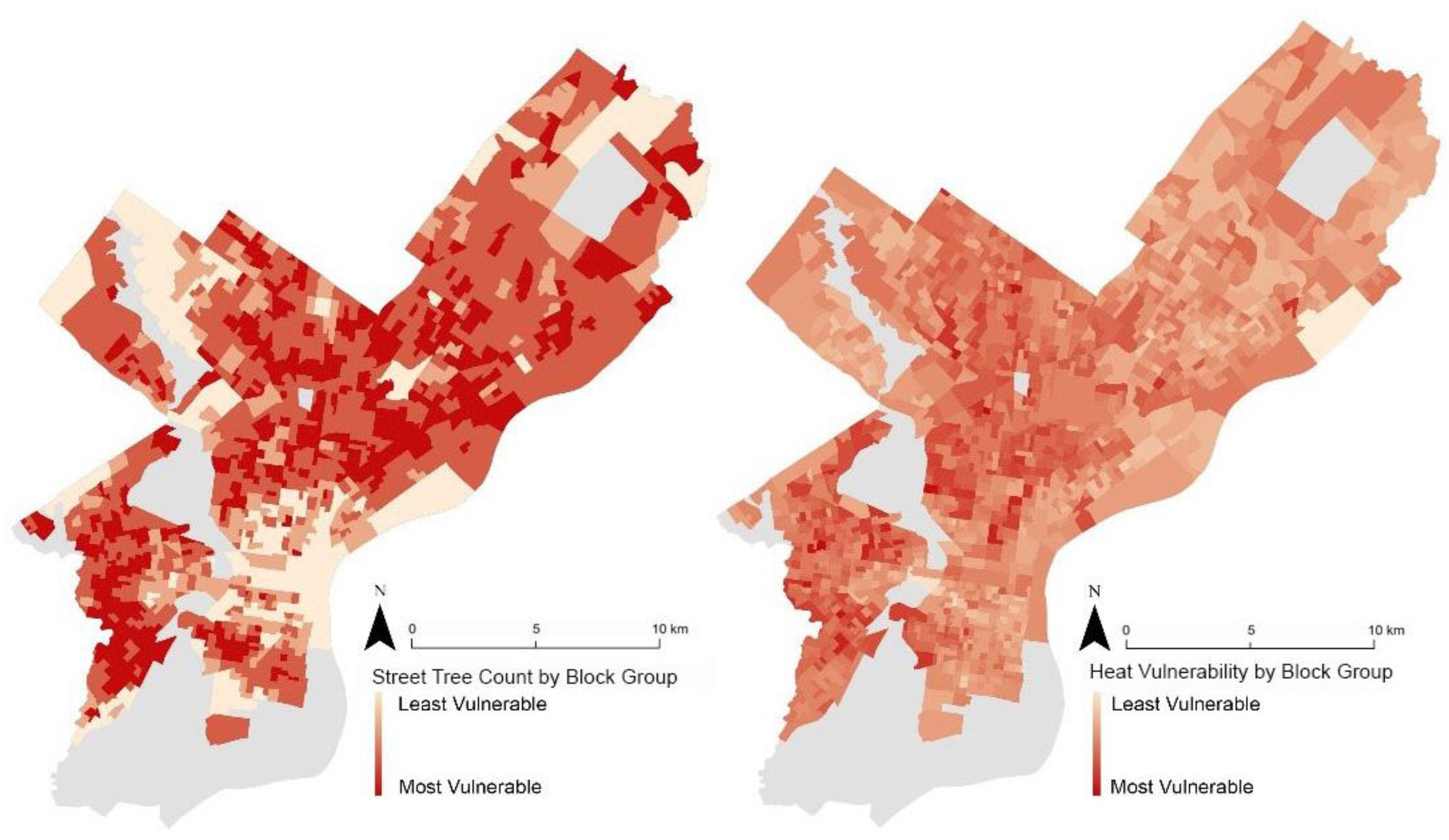
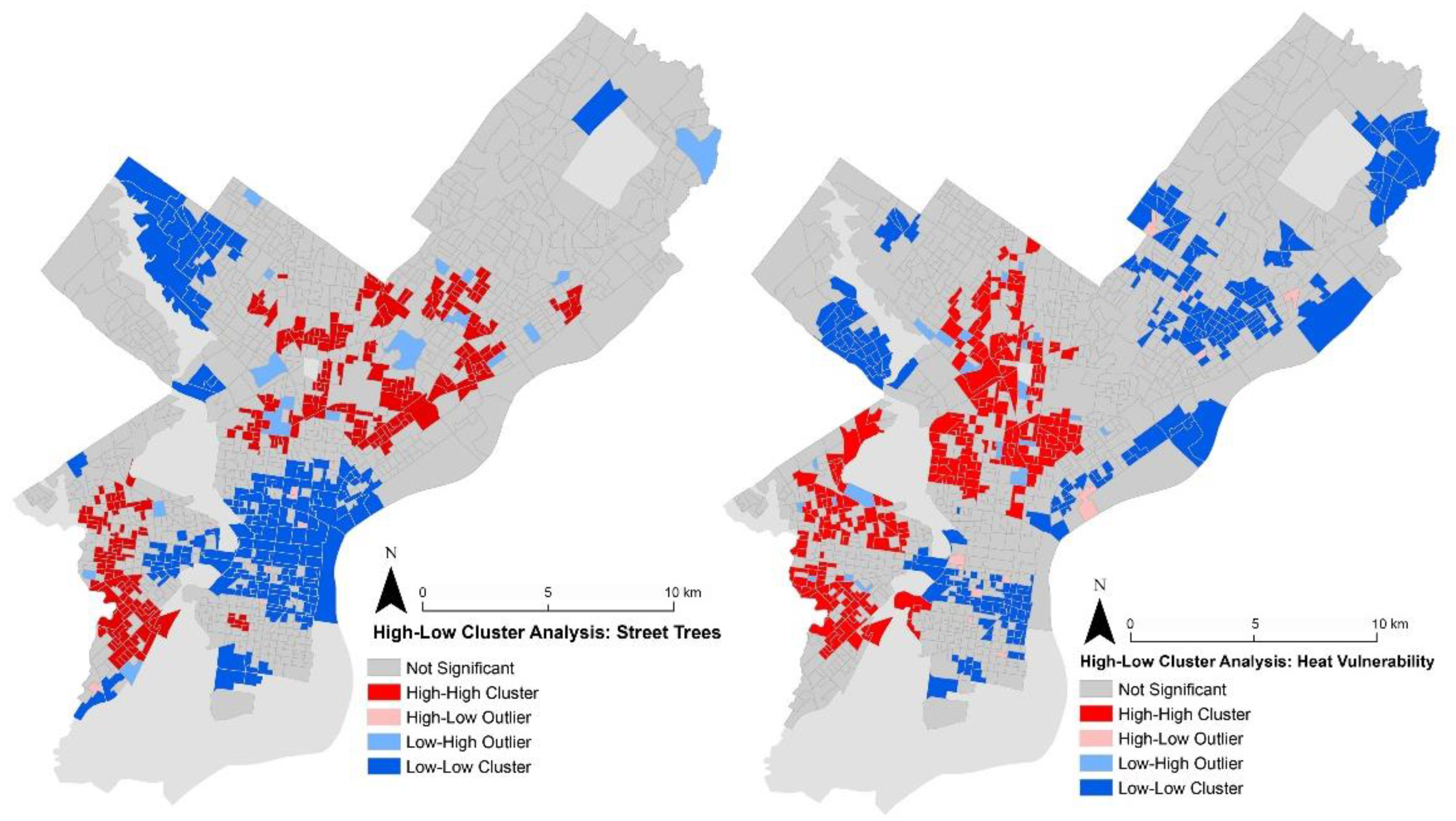
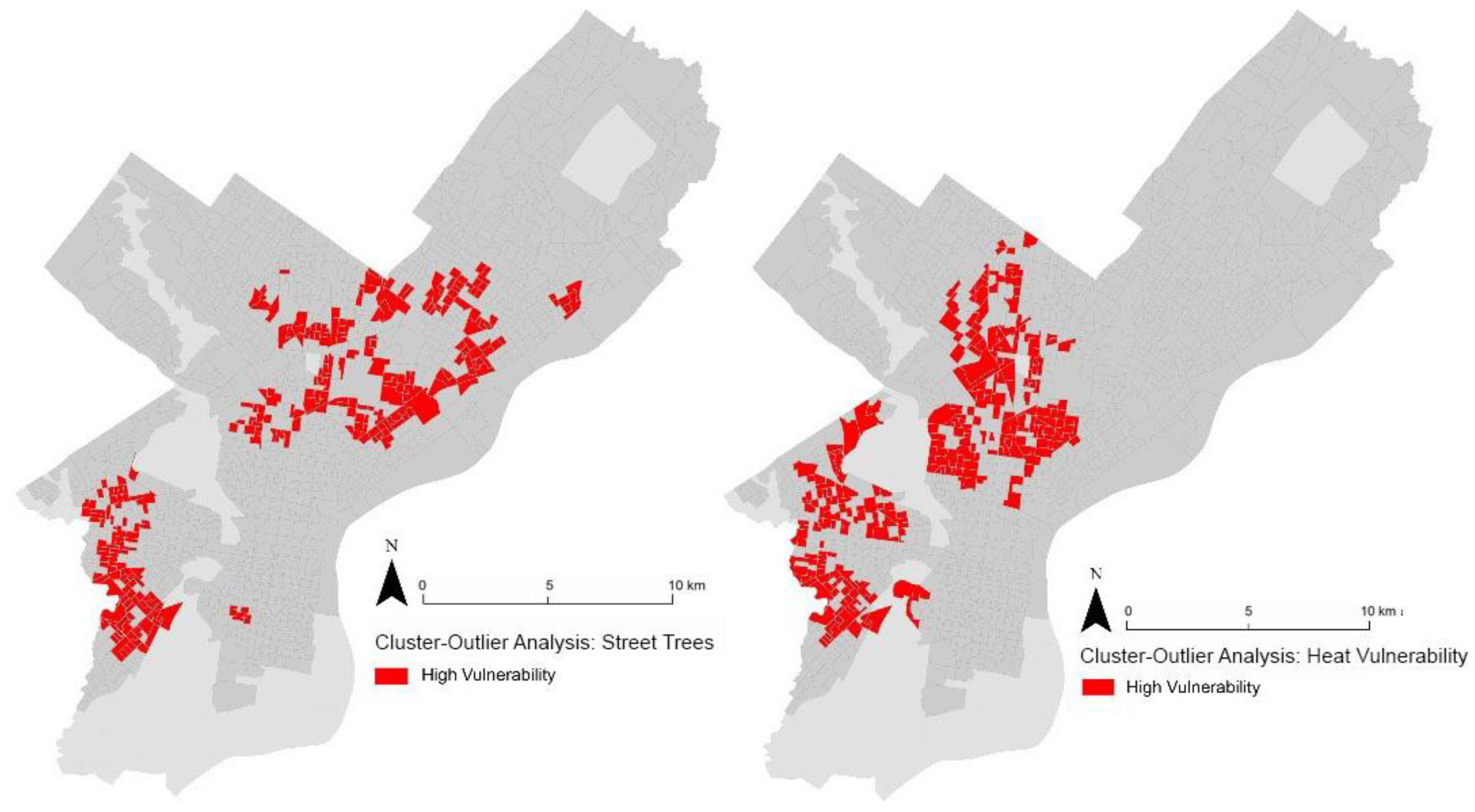
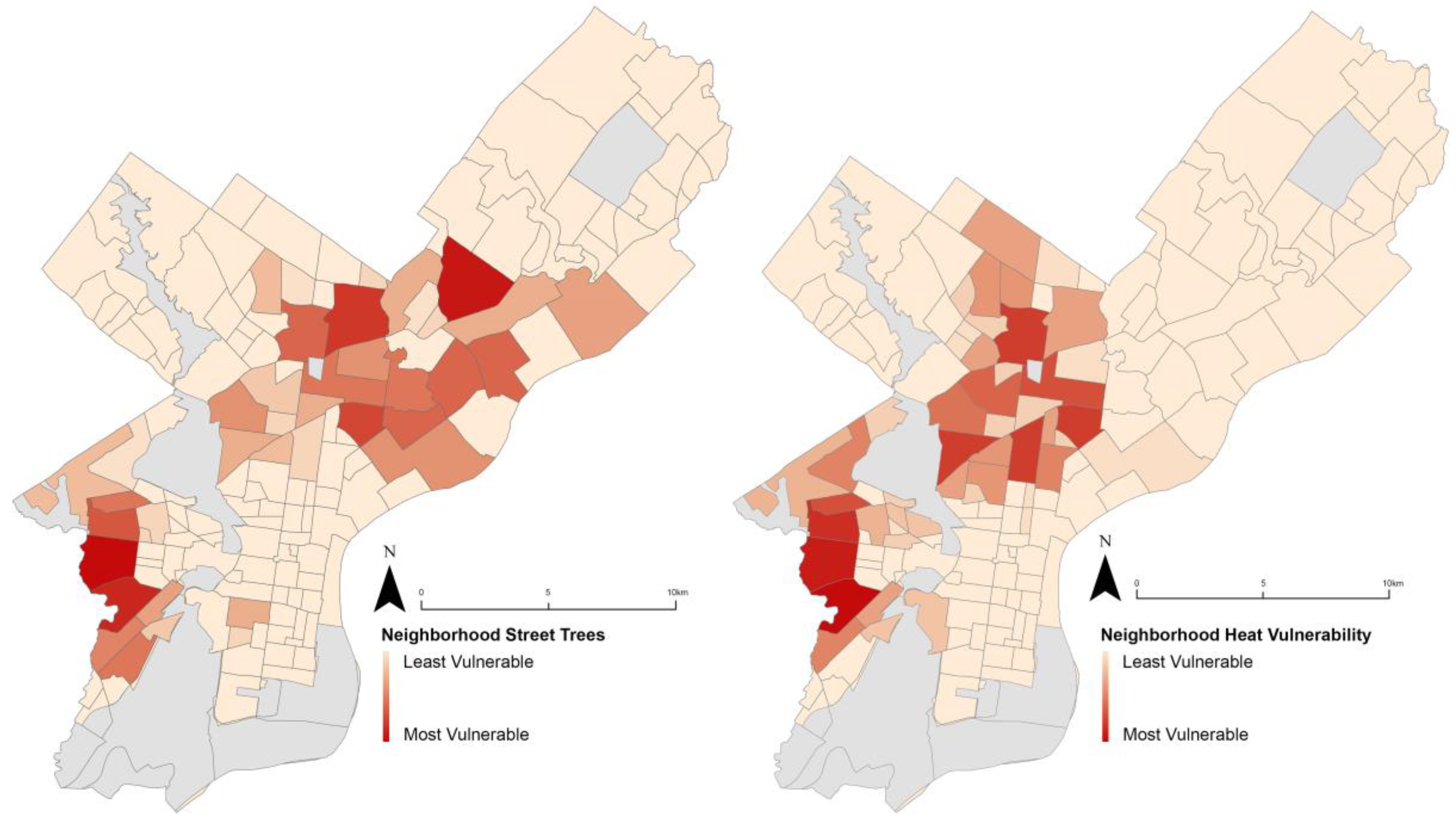
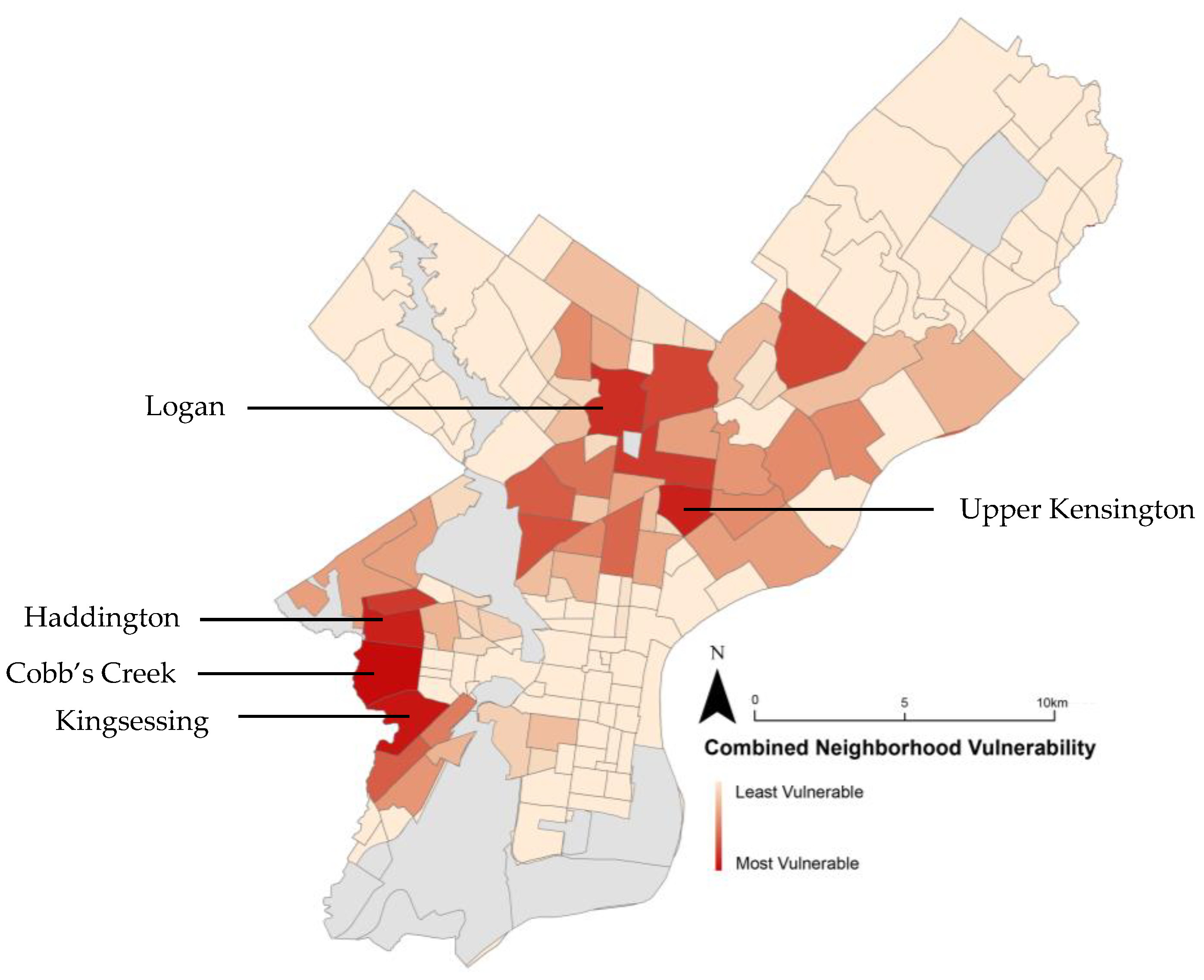
| Output Type | Output Description |
|---|---|
| Low-low vulnerability | The block is significantly lower in vulnerability than all other blocks, the neighborhood is significantly lower in vulnerability than all other neighborhoods. |
| Low-high vulnerability | The block is significantly lower in vulnerability than all other blocks, the neighborhood is significantly higher in vulnerability than all other neighborhoods. |
| High-low vulnerability | The block is significantly higher in vulnerability than all other blocks, the neighborhood is significantly lower in vulnerability than all other neighborhoods. |
| High-high vulnerability | The block is significantly higher in vulnerability than all other blocks, the neighborhood is significantly higher in vulnerability than all other neighborhoods. |
© 2018 by the authors. Licensee MDPI, Basel, Switzerland. This article is an open access article distributed under the terms and conditions of the Creative Commons Attribution (CC BY) license (http://creativecommons.org/licenses/by/4.0/).
Share and Cite
Barron, L.; Ruggieri, D.; Branas, C. Assessing Vulnerability to Heat: A Geospatial Analysis for the City of Philadelphia. Urban Sci. 2018, 2, 38. https://doi.org/10.3390/urbansci2020038
Barron L, Ruggieri D, Branas C. Assessing Vulnerability to Heat: A Geospatial Analysis for the City of Philadelphia. Urban Science. 2018; 2(2):38. https://doi.org/10.3390/urbansci2020038
Chicago/Turabian StyleBarron, Laura, Dominique Ruggieri, and Charles Branas. 2018. "Assessing Vulnerability to Heat: A Geospatial Analysis for the City of Philadelphia" Urban Science 2, no. 2: 38. https://doi.org/10.3390/urbansci2020038





